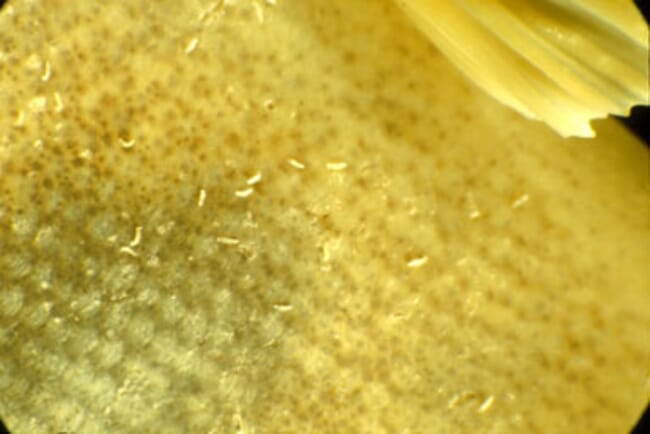What is it?
Gyrodactylus are small, leech-like parasites. Over 400 species have been described, from fish and frogs, in fresh and salt water. In Norway, catastrophic losses of Atlantic salmon were seen following the introduction of G. salaris to the country in the 1970s. As of 2001, 41 Norwegian rivers have been infected and their salmon populations effectively exterminated. These parasites are remarkable in that they give birth to live young. The daughter parasite is the same size as the mother, and inside this daughter there is already a developing granddaughter, in a "Russian doll" arrangement.
Where and when might it occur?
Only Atlantic salmon are severely affected by this parasite, although G. salaris has been reported from Atlantic salmon (Salmo salar), rainbow trout (Oncorhynchus mykiss), Arctic char (Salvelinus alpinus), North American brook trout (Salmo fontinalis), grayling (Thymallus thymallus), North American lake trout (Salvelinus namaycush) and brown trout (Salmo trutta). Salmon from Scottish rivers have also been shown to be susceptible to this parasite.
Diagnosis
The parasite can be seen under low power magnification, for example, with a good hand lens. Without magnification, heavily infected parr appear greyish, with excess mucus, and possibly concurrent fungal infections.

Gyrodactylus salaris give birth to live young
They attach to the host by the attachment organ, or opisthaptor at one end of the body and feed using glands at the other end. Attachment can cause large wounds and feeding can damage the epidermis, allowing secondary infection. G. salaris can build up to very high infection intensity of several thousand parasites on a single salmon parr.
Treatment and control measures
Rotenone treatment has been used to eradicate G. salaris from some rivers in Norway. This kills all fish in the river, and restocking is carried out from eggs and juveniles collected prior to treatment. Not all rotenone treatments have been successful, and such drastic treatment is only possible in short rivers with favourable biological and geographical conditions. The parasite cannot survive full strength sea water, so natural migration of fish is unlikely to spread infection.
Following a programme of intensive sampling to prove absence of G. salaris in the UK, special safeguard measures have been awarded to prevent movement of salmonid fish from areas that are, or may be, infected with G. salaris, to the UK (Commission Decision 96/490/EC).
Source: Fisheries Research Services
Crown copyright 2007
FRS is an agency of the Scottish Executive
